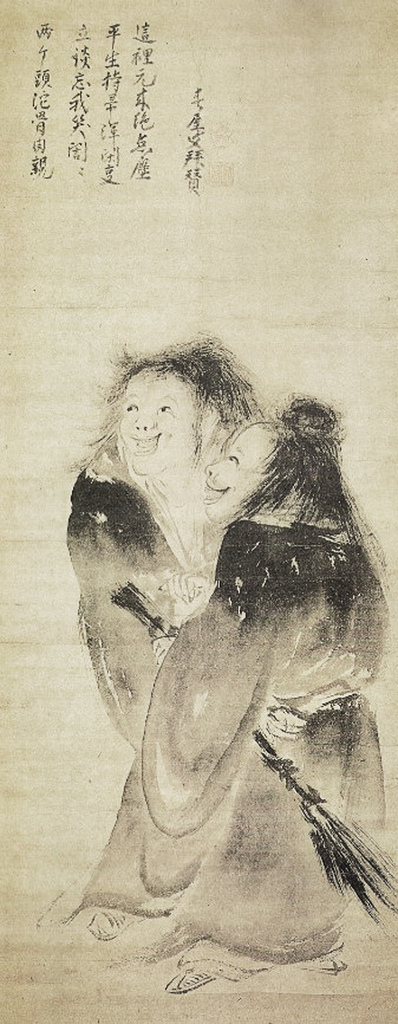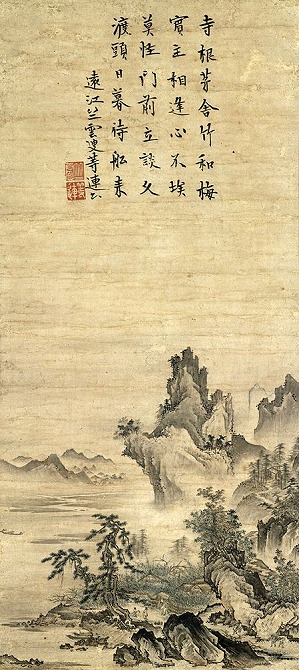ZEN MESTEREK ZEN MASTERS
« Zen főoldal
« vissza a Terebess Online nyitólapjára
天章周文 Tenshō Shūbun (1414-1463)
Tartalom |
Contents |
| The Ten Oxherding Pictures
十牛圖頌 Shiniu tusong (Japán olvasat:) Jūgyū zuju (Magyar átírás:) Siniu tuszung A bivalyhajtás tíz képe / A bika hazaterelése Illusztráció: 天章周文 Tenshō Shūbun (1414-1463) |
The Ten Oxherding Pictures |
Tenshō Shūbun (天章 周文, died c. 1444–50) was a Japanese Zen Buddhist monk and painter of the Muromachi period.
He was born in the late 14th century in Ōmi Province and became a professional painter around 1403. He settled in Kyoto, then the capital city. He became director of the court painting bureau, established by Ashikaga shoguns, which consisted of influential art patrons. He was chosen by the members of the diplomatic mission to Joseon in 1423.
Shūbun is considered to be the founder of the Chinese style of suiboku ink painting. He was also influenced by Chinese landscape painter Xia Gui and Ma Yuan
Throughout his life, Shūbun was associated with the famous Zen Buddhist temple, Shōkoku-ji. Early in his career, he studied painting there under Josetsu, a Chinese immigrant who became the father of the new Japanese ink painting tradition. Under Josetsu's influence, Shūbun started studying Chinese Song Dynasty painting by masters such as Xia Gui and Ma Yuan; consequently, Shūbun's style was an intermediate step between early Japanese artists who imitated Chinese models very closely, and later artists, who developed a national style. Later in life, Shūbun became overseer of buildings and grounds at Shōkoku-ji.
In the 1440s he taught the young Sesshū Tōyō, who became his best pupil and the most highly regarded Japanese artist of his time. Another important pupil may have been Kanō Masanobu, who succeeded Shūbun as the chief painter of the Ashikaga shogunate, and also founded the Kanō school of painting.
Shūbun's most well-known painting, designated as a National Treasure in Japan, is Reading in a Bamboo Grove, now kept in the Tokyo National Museum. The same museum houses a few other works attributed to Shūbun, among them a pair of folding screens (屏風 byōbu) titled Landscape of Four Seasons (四季山水図屏風 Shiki sansui zu byōbu). Two more pairs of folding screens depicting landscapes of the four seasons are held by the Seikadō Bunko Art Museum. As with many Japanese and Chinese artists of this and earlier periods, many works survive that are attributed to Shūbun, but only for a few is this attribution secure. Contemporary accounts describe Shūbun as a very versatile artist, yet the only extant works with the authorship issue resolved are landscapes.

寒山拾得図 Portraits of Kanzan and Jittoku
Important Cultural Property
伝周文筆/春屋宗園賛
Attributed to Shūbun, inscription by Shunoku Sōen
1 hanging scroll
Ink on paper
99.6 x 36.9 cm
Tokyo National Museum

山水図 Landscape
75.5 x 34.0 cm
Attributed to Shūbun. Inscription by 竺雲等連 Jikuun Tōren
Tokyo National Museum
http://en.wikipedia.org/wiki/Tensh%C5%8D_Sh%C5%ABbun
http://fr.wikipedia.org/wiki/Sh%C5%ABbun
http://ja.wikipedia.org/wiki/%E5%91%A8%E6%96%87
https://de.wikipedia.org/wiki/Sh%C5%ABbun
http://burkecollection.org/catalogue/105-landscape-after-ka-kei-ch-xia-gui-fl-ca